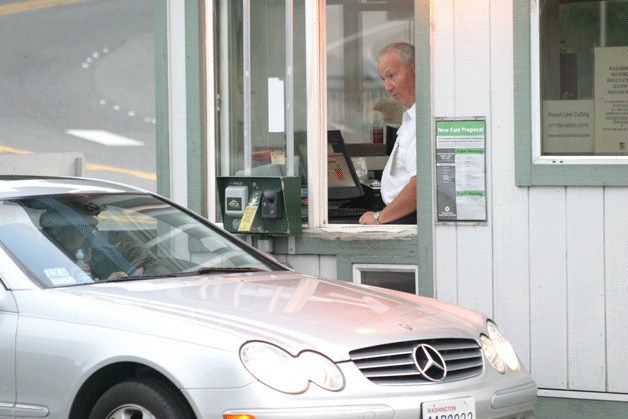CLINTON — Ferry riders are grudgingly accepting the upcoming increase in ferry fares.
Ferry riders across the state, including those who use the Clinton-Mukilteo route, will pay 25 cents more per fare starting Oct. 1. The increase will help pay for new ferries.
Additionally, general fares will increase 2.5 percent. It’s the first of two increases — the second, a 3 percent increase, takes effect May 1, 2012.
Riders aren’t thrilled with the higher fares, but said there’s not much they can do besides open their wallets.
“I think they could probably charge whatever they want,” Bob Bissett said as he sat in the ferry cafeteria, enjoying a beer, heading toward Mukilteo.
Bissett said he travels on the ferry a few times a month for work. As a construction worker from Monroe, he saw the options other than taking the ferry as too costly, even with the increased fares.
“Even if I worked here every day, I’d still take the ferry,” Bissett said.
He estimated it costs him $25 to travel from Monroe to his work sites on Whidbey Island, including gas and ferry fares. To travel around by driving north to Deception Pass, he figured the cost would double to $50.
“We still save money,” Bissett said. “You’ve got to pay, one way or another. If you want the convenience of sitting on the ferry, you can make that choice.”
The cost to travel one way from Clinton to Mukilteo on Oct. 1 will be $7.60 for a standard vehicle, based on the immediate fare increases.
Another change may benefit small-car commuters.
To maximize ferry deck usage, the Washington State Transportation Commission created a new category for cars less than 14 feet; drivers of those vehicles will pay 70 percent of the standard vehicle fare by 2013.
Beginning in October, those small cars will pay 90 percent of standard fare, and 80 percent by May. Also, the standard vehicle size was redefined as 14 to 22 feet.
For grandfather Steve Abercrombie of Langley, who drives his grandchildren in his SUV, the changes don’t help him much.
He questioned the commission’s need to encourage smaller cars while not aiding SUVs like his.
“We’re going to fill it on busy times anyway, so why does the size of the car matter?” Abercrombie asked.
At least a few times each week, he travels to the mainland to pick up his grandchildren and visit his family. He said he understood the reason for the higher fares, however.
“I see the need for increasing revenue,” Abercrombie said.
A ferry commuter since 1962, he watched ferry fares rise almost every year, not necessarily in line with other costs.
“I’ve seen it increase much higher than cost of living, housing and other indicators of cost raises,” Abercrombie said.
He said he there was nothing to be done to keep fares as-is.
“Not increasing it is a seemingly futile fight,” he said.
To curb unexpected spikes in fuel costs, the commission also approved a measure to charge travelers more when gas prices go up.
Fares will go up by 2.5 percent when fuel exceeds $3.86 per gallon. Fuel would have to increase to $4.08 per gallon to activate the surcharge, which is capped at 10 percent.
Annual bicycle permits are being canceled. However, passengers with monthly passes, multi-ride cards and an ORCA ePurse may bring bicycles aboard vessels without additional charges.



